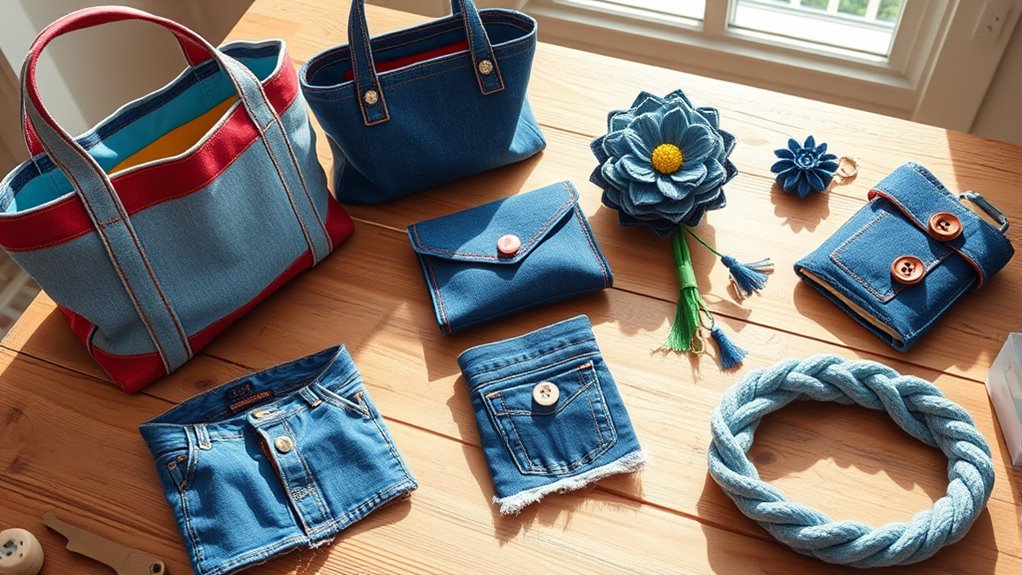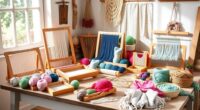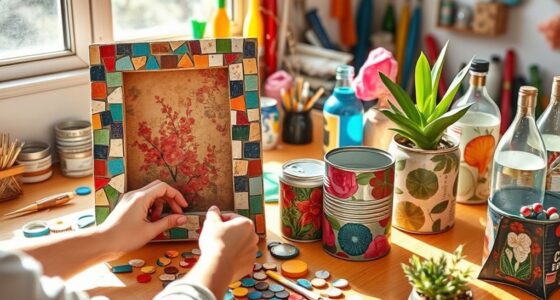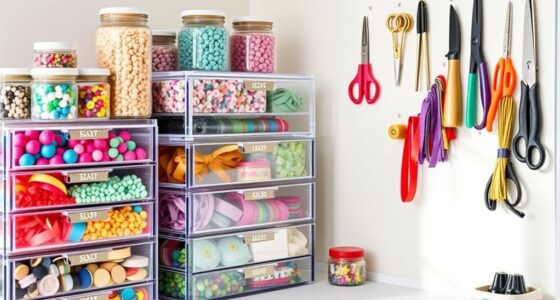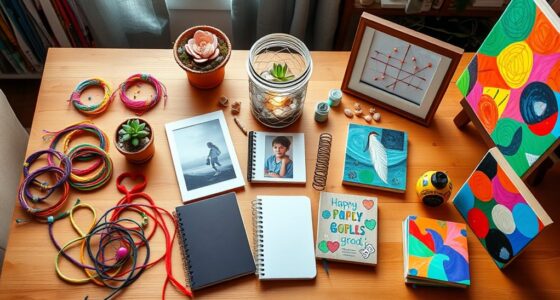You can transform old denim jeans into a variety of stylish and functional crafts like tote bags, coasters, pillow covers, snack bags, and jewelry. You might also create upcycled planters, slippers, or wall art, using simple sewing and decorative techniques. Choosing the right denim and adding personal touches like patches or embroidery makes your projects unique. Keep exploring different ideas and techniques to turn your old jeans into charming, eco-friendly accessories and decor.
Key Takeaways
- Transform old jeans into stylish accessories like tote bags, jewelry, and planters through cutting, sewing, and decorating techniques.
- Create functional home décor items such as pillow covers and coasters, adding embellishments for personalization.
- Use eco-friendly upcycling methods to reinforce seams, seal designs, and ensure durability of denim crafts.
- Incorporate decorative elements like embroidery, patches, and paint to customize your denim projects.
- Line or reinforce denim with waterproof fabrics for washable snack bags and water-resistant coasters.
Denim Tote Bag
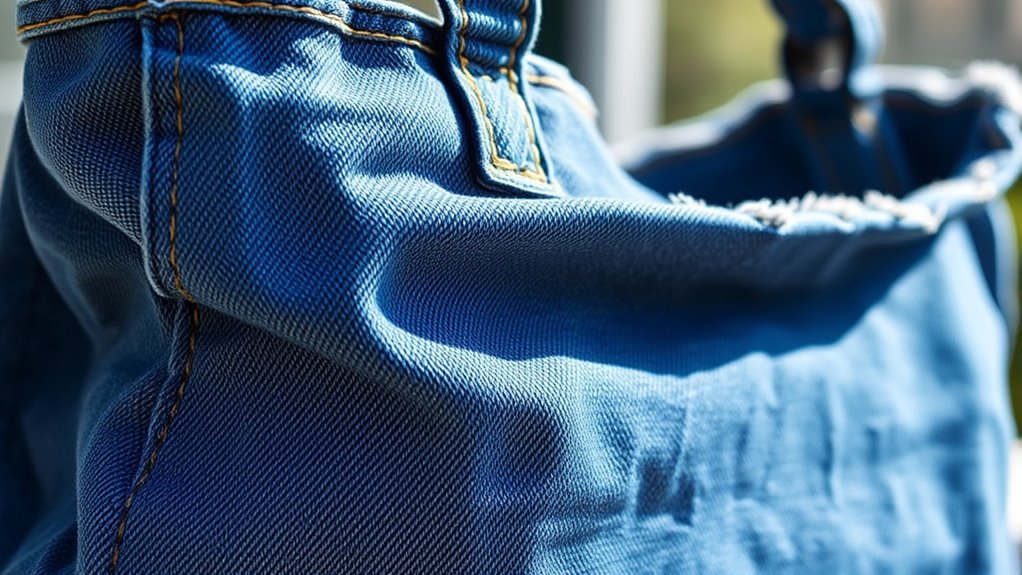
Creating a denim tote bag is a simple and eco-friendly way to repurpose old jeans. You just need some basic sewing skills and a few supplies. Start by cutting a large rectangle from the denim, approximately 15 inches wide and 16 inches tall. Then, cut two strips for the handles, about 20 inches long and 2 inches wide. Fold the edges of the rectangle inward and sew to create clean hems. Attach the handles to the top of the bag by sewing them securely on each side. Reinforce the bottom and sides with extra stitches for durability. Including proper stitching techniques can ensure your tote bag holds up over time. Utilizing suspension upgrades and reinforced seams can add extra strength to your DIY project. This project transforms worn-out jeans into a functional, stylish tote perfect for shopping, books, or everyday use. Plus, it’s a fun way to give your old denim new life.
Stylish Denim Coasters
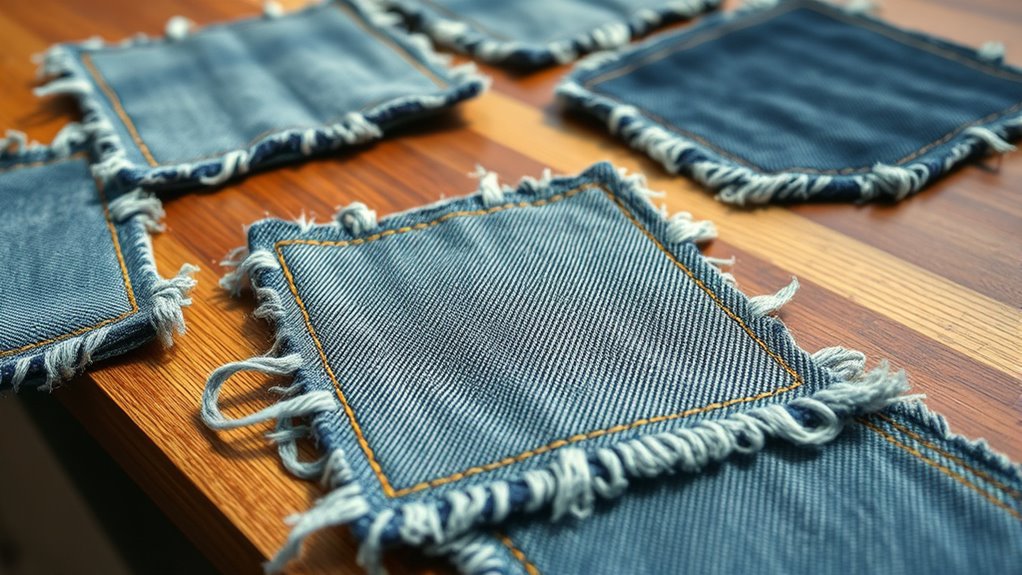
To make stylish denim coasters, start by cutting and shaping your fabric into perfect circles or squares. Then, add decorative elements like stitching, embellishments, or paint to personalize each piece. Finish by sealing and securing your coasters to guarantee durability and a polished look.
Cutting and Shaping Techniques
When making stylish denim coasters, precise cutting and shaping are essential to achieve a clean, professional look. Start by measuring and marking your fabric with a ruler and fabric chalk, ensuring uniform size. Use sharp scissors or rotary cutters for clean edges, cutting along your marked lines carefully. For rounded corners, trace a small circular object like a lid or jar to create smooth curves. To shape the edges, gently trim any uneven spots or frayed areas, ensuring the coaster has a neat finish. If you’re layering denim for thickness, cut each piece to the same size before stacking. Consistency in size and smooth edges give your coasters a polished appearance and make the assembly process easier. Precision in cutting truly elevates your craft result. Additionally, selecting high-quality denim can enhance the durability and aesthetic of your finished coasters, as fabric quality significantly impacts performance and quality. Using proper tools such as rotary cutters and cutting mats can also make the process safer and more accurate. Incorporating sound scientific principles like proper measurement techniques can further improve the precision of your cuts and overall craftsmanship.
Adding Decorative Elements
Adding decorative elements can instantly enhance the style of your denim coasters, making them unique and personalized. You can sew colorful stitches around the edges for a vibrant touch or add fabric patches for extra flair. Embroidery offers a creative way to incorporate patterns, initials, or designs that reflect your personality. Applying iron-on decals or fabric paint allows you to create detailed images or messages without much effort. You might also consider attaching small embellishments like buttons, beads, or studs to add texture and visual interest. Keep in mind, these decorative choices should complement your overall aesthetic. Incorporating creative designs with different textures and materials can elevate the look of your denim coasters even further. Adding variety in textures and materials can help you achieve a more dynamic and eye-catching appearance. Exploring merchant services can be beneficial if you decide to sell your handcrafted coasters online or at craft fairs, providing secure payment options for your customers. Additionally, experimenting with different decorative techniques can inspire new ideas and help you develop a signature style for your creations. For example, using self-watering plant pots as a theme or motif can add a unique touch to your designs. By customizing with decorative elements, your denim coasters will stand out and become functional art pieces that showcase your creativity and style.
Sealing and Finishing
Once you’ve decorated your denim coasters to reflect your personal style, sealing and finishing them guarantees they not only look great but also last longer. Start by applying a clear sealant or fabric spray evenly over the surface to protect your design from spills and wear. Make sure to work in a well-ventilated area and follow the product instructions carefully. For extra durability, consider applying a thin layer of waterproof mod podge or a clear acrylic sealer with a brush. Allow each coat to dry thoroughly before adding another. Finishing with a soft matte or glossy topcoat enhances the appearance and provides a protective barrier. This sealing process ensures your stylish denim coasters stay vibrant and intact through everyday use. Proper sealing also helps prevent damage from moisture, keeping your coasters looking new for longer. Additionally, understanding financial aspects such as setting a timeline for completing your project can help you stay on schedule and avoid unnecessary delays. Incorporating proper sealing techniques can further improve the longevity of your coasters and ensure they withstand regular use without deterioration.
Chic Denim Pillow Covers
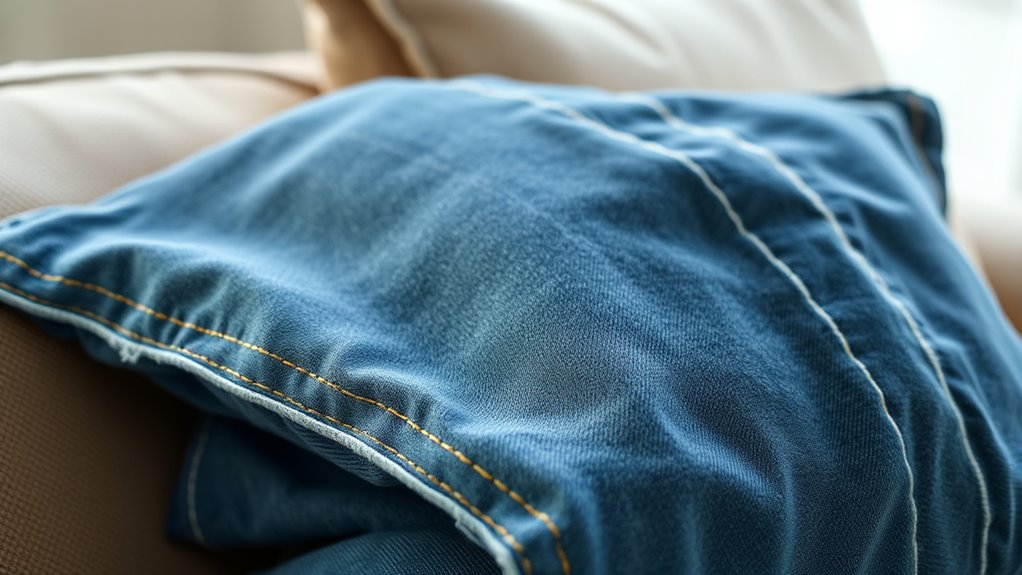
To create chic denim pillow covers, start by choosing the right denim that’s sturdy yet soft enough for comfort. Use precise cutting and sewing techniques to guarantee a clean fit, and consider adding decorative elements like embroidery or patches to personalize your design. With a bit of creativity, your pillows will seamlessly blend style and sustainability. Additionally, ensure your denim is properly prepared by washing and drying it thoroughly to prevent shrinkage after sewing. Being aware of regional resources can also help you find quality supplies and inspiration for your project. Incorporating eco-friendly upcycling techniques can further enhance your sustainable approach to crafting. Moreover, selecting denim with unique textures can add visual interest and character to your pillow covers. Exploring fabric care tips can help maintain the quality and appearance of your denim over time.
Selecting the Perfect Denim
When selecting denim for chic pillow covers, choosing the right fabric is essential to achieve both style and durability. First, consider a medium weight denim, which offers structure without being stiff. Second, look for denim with minimal stretch, ensuring your pillow stays crisp and holds its shape. Third, check the fabric’s color and fading; darker, even-toned denim provides a sleek, modern look, while distressed or faded options add character. Feel the fabric for softness—smooth denim feels more comfortable against skin. Also, examine the weave; tight weaves are stronger and last longer. Additionally, paying attention to the fabric’s storage properties can help maintain its appearance over time. Choosing a denim with good colorfastness ensures your pillow covers retain their vibrant look after multiple washes. By paying attention to these details, you’ll select denim that’s both attractive and resilient, making your pillow covers stand out and last through countless washes.
Cutting and Sewing Tips
Before you start cutting your denim, make sure to wash and iron the fabric to remove any wrinkles and stabilize the fibers. This step guarantees cleaner cuts and easier sewing. When cutting, use sharp scissors or a rotary cutter for precise edges. Always measure twice and cut once to avoid mistakes. For sewing, choose a heavy-duty needle designed for denim and use a straight or zigzag stitch for durability. To prevent fraying, finish raw edges with a serger or zigzag stitch. Keep fabric taut to maintain straight lines, and press seams flat as you sew. Here’s a quick guide:
| Tip | Explanation |
|---|---|
| Use sharp tools | Ensures clean, accurate cuts |
| Sew with heavy-duty needle | Handles thick denim comfortably |
| Finish raw edges | Prevents fraying and extends pillow life |
| Press seams as you go | Achieves a professional finish |
Adding Decorative Elements
Adding decorative elements can instantly elevate your denim pillow covers, giving them a personalized and chic look. You can do this with simple touches that make a big impact. First, consider adding embroidery or fabric paint to create unique patterns or initials. Next, sew on contrasting patches or lace trims along the edges for texture and visual interest. Finally, attach decorative buttons or studs in a strategic pattern to add a bit of sparkle or edge. These small details turn a plain denim cover into a standout piece. Visualize colorful embroidery swirling across the surface, lace accents peeking from the corners, or shiny buttons lining the zipper. Each element adds character and charm, making your pillow cover truly one-of-a-kind.
Reusable Denim Snack Bags
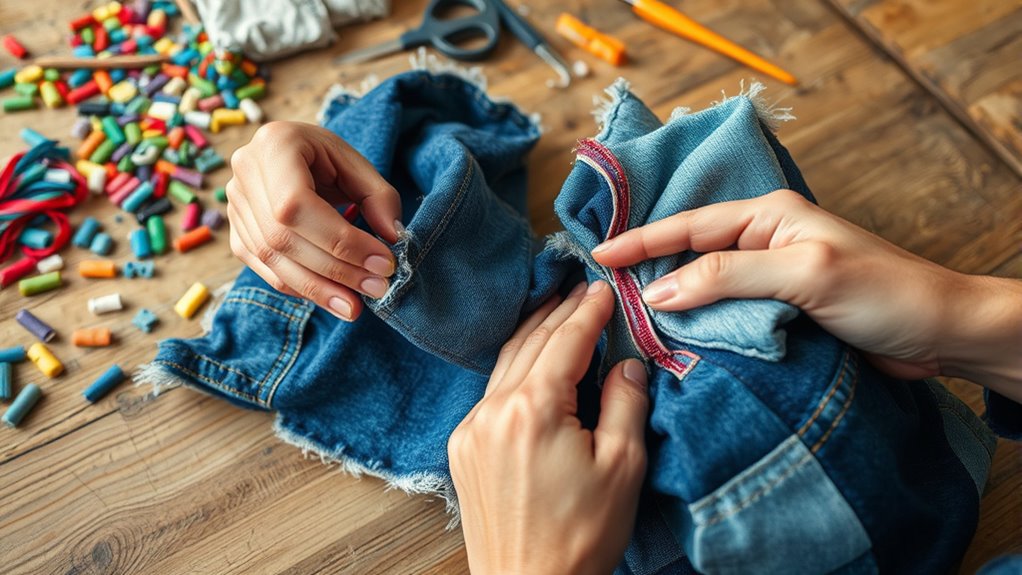
Ever thought about turning old denim jeans into eco-friendly snack bags? You can easily create reusable denim snack bags to cut down on waste and keep snacks fresh. Start by cutting a rectangle from the denim, about 8×6 inches. Fold the fabric in half, with the right sides facing each other. Sew along the sides and bottom, leaving the top open. To make it more secure, add a Velcro or snap closure at the top. Finish by lining the inside with waterproof fabric or a plastic liner for easy cleaning. These snack bags are perfect for packing fruit, nuts, or crackers. Plus, they’re durable, washable, and stylish, giving your old jeans a second life while helping the environment.
DIY Denim Jewelry
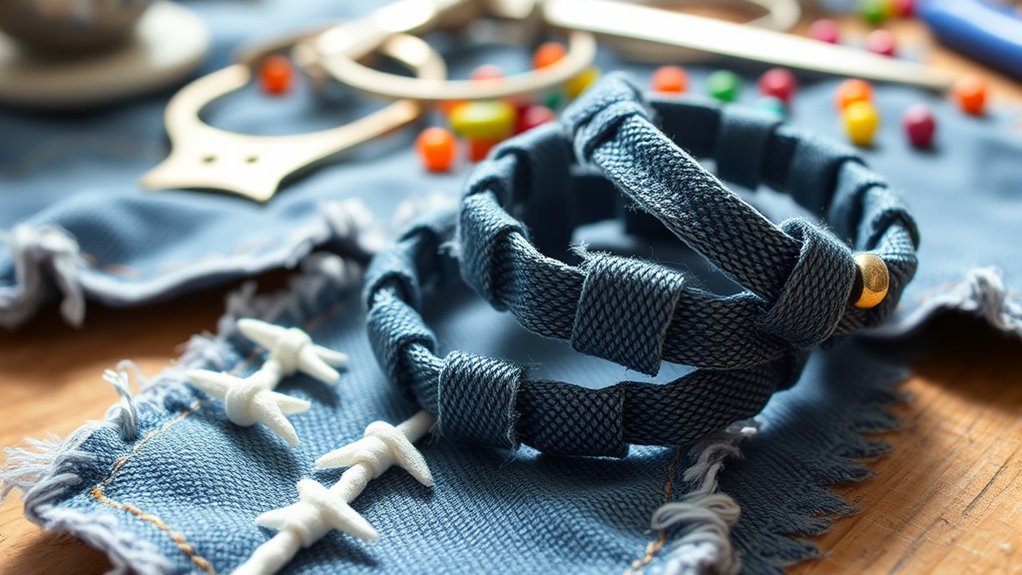
Transforming old denim jeans into jewelry is a fun and creative way to repurpose fabric while making unique accessories. To start, gather your favorite denim scraps and small tools. Imagine this:
- Cutting strips of denim into thin, even pieces.
- Bending and twisting these strips into rings or pendants.
- Stringing beads or denim pieces onto sturdy jewelry wire or cord.
You can create bold bracelets, quirky earrings, or eye-catching necklaces. Use metal clasps or simple knots to secure your designs. Embellish with buttons, studs, or fabric paint for extra flair. The best part? You get personalized pieces that reflect your style and sustainability goals. With some basic supplies and a little imagination, denim jewelry becomes an accessible, eco-friendly craft to try today.
Upcycled Denim Planters

Repurposing old denim jeans into planters offers a durable and stylish way to display your greenery. Start by cutting a leg of the jeans and trimming the hem for stability. Punch small drainage holes at the bottom to prevent waterlogging. You can reinforce the interior with a plastic bag or container to hold soil and plants securely. Turn the denim inside out and line it with a plastic liner if needed. Fill it with soil, then plant your favorite flowers or herbs. The denim adds a rustic, casual look to your space while protecting the roots. Place your upcycled denim planter on a patio, balcony, or windowsill, and enjoy your eco-friendly, creative display. It’s a simple project that transforms old jeans into a functional art piece.
Cozy Denim Slippers
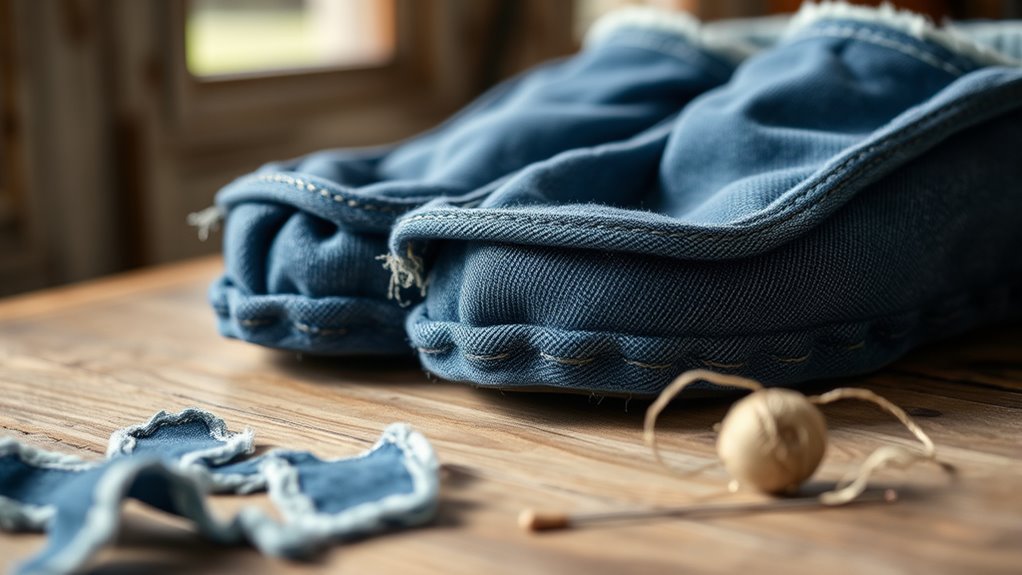
If you’re looking for a comfortable and eco-friendly way to keep your feet warm, making cozy denim slippers is a great DIY project. Start by cutting your old jeans into the shape of slipper soles and uppers. Then, follow these steps:
- Sew the denim pieces together, creating a snug fit around your foot.
- Add a soft lining, like fleece or felt, for extra warmth and comfort.
- Attach a sturdy denim sole, reinforced with glue or stitching, for durability.
Imagine slipping your feet into these plush, custom-made slippers, crafted from your favorite worn jeans. They’re perfect for relaxing at home while giving new life to old denim. Plus, they’re quick to make and eco-friendly!
Custom Denim Wall Art
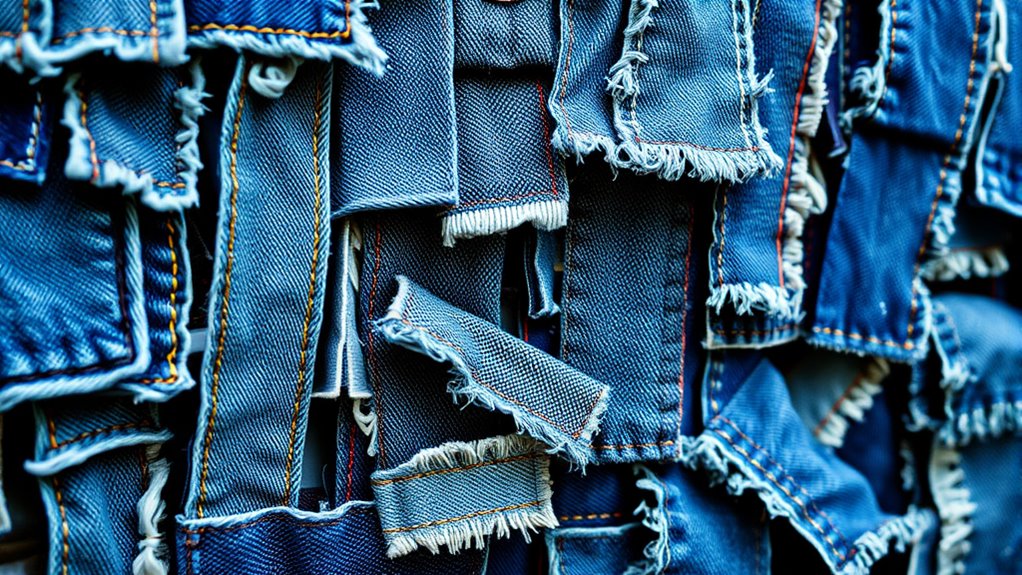
After creating cozy denim slippers from your old jeans, you can extend their charm by turning denim into unique wall art. Begin by cutting denim into various shapes—hearts, stars, or abstract patterns. Layer and sew these pieces on a canvas or frame for a textured effect. To add visual interest, incorporate fabric paint or embroidery.
Here’s a quick idea to inspire your project:
| Design Idea | Material Needed |
|---|---|
| Denim Patch Collage | Assorted denim scraps |
| Embroidered Quotes | Denim, embroidery thread |
| Framed Denim Art | Denim pieces, frame |
Mix and match these ideas to create a personalized display that showcases your style and repurposed denim.
Frequently Asked Questions
How Can I Prevent Denim From Fraying During Cutting?
When you’re cutting denim, it’s common for the edges to fray. To prevent this, you should first wash and dry your jeans to soften the fabric. Use sharp scissors for a clean cut, and cut slowly along your marked lines. For extra protection, apply a fabric sealant or fray check along the edges immediately after cutting. You can also sew or zigzag stitch around the edges to keep fraying at bay.
What Tools Are Essential for Denim Craft Projects?
When you start a denim craft project, having the right tools makes all the difference. You’ll want sharp fabric scissors to get clean cuts, a rotary cutter for precise edges, and a cutting mat to protect your surfaces. A strong sewing machine or needle and heavy-duty thread are essential for stitching. Additionally, pins or clips help hold pieces in place. These tools guarantee your project turns out neat and professional-looking.
How Do I Choose the Right Denim for Different Crafts?
Choosing the right denim is like picking the perfect brush for your masterpiece. You want sturdy, thick fabric for durable projects like bags, and softer, lighter denim for delicate crafts like patches or accessories. Feel the texture—denim with a tight weave offers strength, while looser weave feels more flexible. Consider the color and wash too, as they set the tone for your craft’s vibe. Pick wisely, and your project will shine.
Can I Use New Denim Instead of Old Jeans?
You can definitely use new denim for your crafts. Fresh denim offers a clean, sturdy material that’s easy to work with and looks great in projects. Just keep in mind that old jeans often have a softer, more worn-in feel, which can add character to your craft. If you prefer a crisp, new look or need stronger fabric, new denim is a perfect choice. Adjust your cutting and sewing accordingly!
How Do I Wash and Care for Denim Crafts?
To keep your denim crafts looking great, wash them in cold water on a gentle cycle, avoiding bleach to prevent fading. Turn your projects inside out to protect the fabric and colors. Air dry whenever possible, or tumble dry on low heat. Store your crafts properly, folding or hanging them to maintain shape. Regular care guarantees your denim projects stay vibrant and durable over time.
Conclusion
Now that you’ve explored these creative ways to repurpose old denim jeans, imagine giving each item a new life—transforming memories into functional art. Just like a blank canvas waiting for your touch, your old jeans hold endless potential. So go ahead, pick your favorite project, and let your imagination run wild. After all, isn’t it satisfying to turn something old into something extraordinary? Jump in and let your creativity denim the way!
